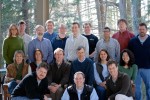Time lags surround us. Want a house? Put a payment down today and the house is built in a couple years. Infected with bacteria? Take penicillin today and the infection should subside in days. Want an education? Begin today and the undergraduate diploma arrives in 16 years.
Unintended time lags abound in rivers and streams. Want to move the Piedmont to production agriculture? Deforest today and tend to your crop for the next decade to earn a nice profit. However, you'll also increase sediment flux for the next centuries. Want even more yield? Over apply cheap nitrogen fertilizers for decades and earn a nice profit. The fertilization safety margin lingers in groundwater, and eventually streams, that may persist for centuries.
Twenty-one scientists discussed these time lags, or legacies, from February 9-11, 2009, at the University of New Hampshire. Our focus was legacies in material fluxes, including water and biogeochemical constituents, from the Long Term Ecological Research (LTER) Network (BES, CWT, HBR, HFR, PIE) and other long-term research sites (Smithsonian Environmental Research Center and US Forest Service experimental forests) in the eastern United States.
The meeting, funded by the National Science Foundation (NSF) through the LTER Network Office and the Northeast Consortium for Hydrologic Synthesis, was driven by the need to understand our contemporary measurements. Are stream samples measuring landscape dynamics from the last year, decade, century, or millennium? Realistic management targets require an understanding of the variety of characteristic time scales and the relative dominance of each on fluxes from the landscape.
The eastern United States has a rich history of human interactions with the landscape. Since European settlement, the sequence of fur and timber harvesting, agricultural production, industrial development, land abandonment, reforestation, and suburbanization provides many permutations of accumulated legacies that we are measuring today. Can we separate responses to the last century and the last decade in our contemporary signal? This question, or its variants, has persisted amongst ecologists, hydrologists, and geomorphologists. Our meeting sought to synthesize existing ideas about legacies and test these ideas in the eastern U.S.
One highlight from the discussion in New Hampshire was that while a strict definition of ...legacy' may be possible, a metric to directly compare legacies is more desirable. The metric we are proposing is the ratio of the time of disturbance to the time of persistence. For example, Compton and Boone (2000) showed how a century of agriculture in central Massachusetts depleted soil nitrogen and altered the soil biogeochemistry for a century or more. Thus, the ratio of disturbance to persistence is at least 1:1. Discussions developing this metric made apparent the tendency of long-term research sites to measure within the time scale of persistence and sometimes neglect the time scale of disturbance. In other words, we know we are measuring a signal from historical dynamics, but have not constructed a solid inventory of historical dynamics to understand which history we are measuring today.
We are currently compiling a cross-site history of the eastern U.S. LTER sites and other long-term sites. By comparing and contrasting the history and material flux measurements across sites, we hope to gain a better understanding of which history we are measuring in our streams and rivers.

 Enlarge this image
Enlarge this image